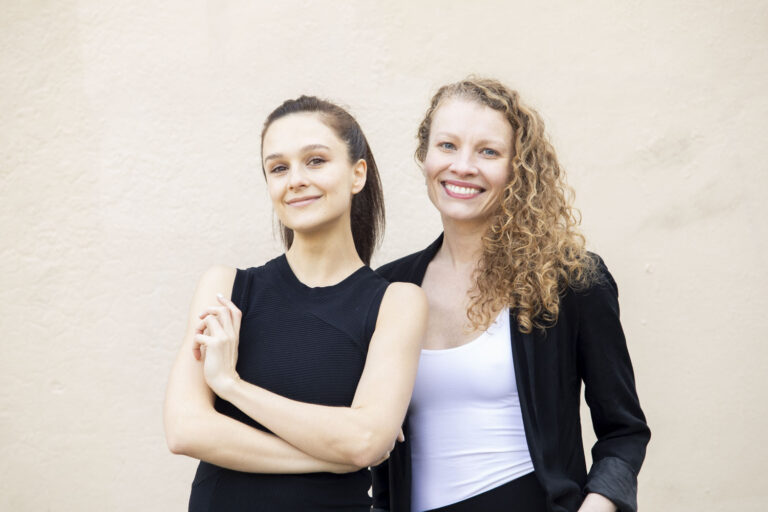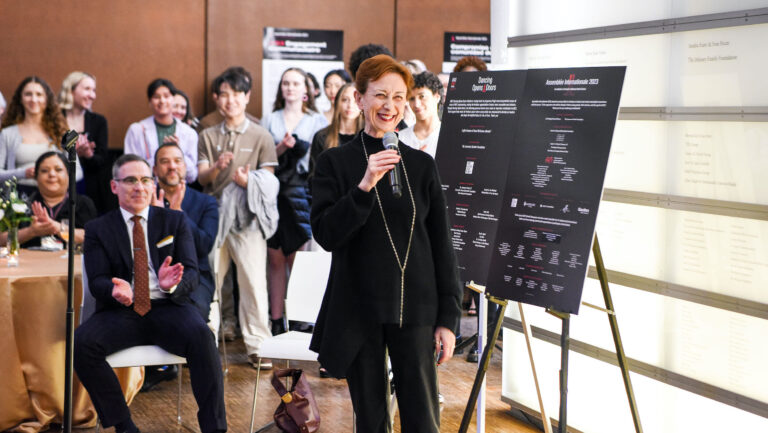
The week before the grand opening of Gibney Dance at 280 Broadway in lower Manhattan, Gina Gibney gave a tour of the 36,000-square-foot space her company leased in January. As she moved from the ground floor where construction was still underway to the second floor where classes were already in full swing, her merry laugh made her seem more like a child delighted with a new toy than a CEO overseeing a multimillion-dollar renovation. At one point, she gathered her miniature dachshund in her arms and settled into a chair. “I can’t believe this,” she says. “I’m as surprised as anybody.”
In January 2014, Gibney Dance became the successor tenant of the dance studio and performance space that the popular Dance New Amsterdam vacated in 2013 after a long financial struggle. Together with her original space, located five subway stops away at 890 Broadway, Gibney now commands 51,000 square feet of space and a budget of more than $4 million, which puts the organization in a league with New York City’s largest dance centers, including The Ailey Studios and Mark Morris Dance Center. And over the months preceding the grand opening, the choreographer and activist at the helm has revealed a vision for the dance community that is as impressive as the physical changes she’s made to the space itself.
To many, Gibney, 57, seemed to come out of nowhere. But the path from directing a contemporary dance company of six to managing some of the most desirable dance space in Manhattan was undertaken with remarkable financial acumen.
Her story is not so different from that of many young dancers who move to NYC to pursue a dance career. Arriving in the 1980s with an MFA degree and $300 in her pocket, she initially supported herself by doing freelance word processing work for a law firm at night (and weekends) so she could dance by day. In 1991, she founded her own company, garnering critical respect and developing a reputation as an activist. In 1999, she created an outreach program for survivors of domestic abuse that provided paying work for her company members.
Then the recession hit. “Halfway through 2010, we started getting bad news from our community action funders,” Gibney says. “We had already planned our budget for the year and committed to dancers to do workshops. It got bad really fast.”
She wasn’t sure she could stay afloat. Yet rather than fold, she took the bold course to expand her operations from one studio to three, when space opened up at 890 Broadway. It was the beginning of the business model she uses today: renting out studio space at market rates to commercial enterprises such as Broadway productions in order to generate sufficient revenue to offer affordable space for nonprofits, hold classes, continue her outreach efforts and rehearse her company. “It was no longer working for us to have one studio and all of the infrastructure necessary to run it,” she says. (Gibney now operates eight studios at 890 Broadway.)

The formerly under-used lobby of 280 Broadway now features a performance space with multimedia capabilities.Photo by Christopher Duggan
That gamble paid off handsomely thanks to sound advice from her board of directors, including founding chair Pamela van Zandt, who brought a business perspective from her careers at Condé Nast publishing and Estée Lauder. Van Zandt is also Gibney’s partner of 25 years.
Gibney and her board weighed carefully the new risks they faced when the New York City Department of Cultural Affairs approached them about 280 Broadway in late 2013. The city had a vested interest in the space, having contributed $2.2 million in support of DNA. And further, unless they could find a qualified cultural tenant to take over the lease, the landlord had the right to rent to a commercial interest. “It was a question of who was really able to do it, had the will to do it and could potentially be successful doing it,” says Kathleen Hughes of the New York City Department of Cultural Affairs. “The monthly cost of sustaining that space is really high.”
“This is a board that never questioned the dream, but they wanted to see the plan,” Gibney says. “For me it’s always been not so much ‘Can we do this?’ as ‘How can we do this?'” she says. That philosophy has guided her business decisions as well as her admirable track record with fundraising.
In the meantime, the $3 million renovation will result in eight studios, three performance spaces and much more. Gibney is particularly enthusiastic about the changes to the ground floor, which was previously underused as a lobby. By turning the staircase into a spiral, there is now a coat check and a performance space with multimedia capabilities. The second floor, along with changing rooms and refurbished studios, now has an art gallery with a café, a digital hub for recording and editing audio and video, a charging zone for mobile devices, a conference room and space for company members and staff to gather, including a kitchen.
Despite the responsibility of managing all this, Gibney remains the same generous-spirited and hardworking friend and colleague she has always been. Her dance teacher at Case Western Reserve University, Kathryn Karipides, recalls a young woman who was “always looking for ways to assist people.” “I just knew that she was going to do wonderful things,” she says.
And such is the spirit that prevailed as the plan for 280 Broadway has emerged. Gibney sees herself as a steward for the good of all. Toward that end, she held a series of town-hall–style meetings with dancers and teachers with the help of the advocacy organization Dance/NYC. “The sessions helped generate community input on the future of 280 Broadway—its vision and programs,” executive director Lane Harwell says.
Gibney has surrounded herself with a staff of highly regarded professionals and partner organizations. Hilary Easton, a longtime choreographer and educator, is creative director of training, education and research. “People feel safe in trusting their support to Gina’s company,” she says. “She has great values.”
Case in point was the decision to bring the Simonson Technique/New Dance Collective faculty from DNA under the Gibney umbrella. Benny Simon was one of the Simonson faculty who were displaced when DNA closed. “We got in touch with Gina and let her know that we had a very large group of students when 280 was our home, and we didn’t want to lose that,” he says. “She immediately said, ‘Of course not! You should be here. Let’s figure it all out.’ So it was a collaboration.” Simon, who has since completed a master’s degree, has become Gibney’s director of marketing.
In addition to Simonson Technique and Gibney’s own Contemporary Forms Program, the center is home to an impressive array of groups, including Movement Research, The Playground (two-hour sessions at $5 for professional dancers to work with visiting choreographers) and Trisha Brown Dance Company.
In June 2014, Craig Peterson (Dance Theater Workshop, Philly Fringe Festival, Philadelphia Live Arts Festival) came on board as director of programs and presentation, tasked with making artistic decisions for the three performance spaces.
And things have only just begun. “I think what is important to note is that there’s so much capacity left,” says Simon. “So much has happened in the last year, but a lot of that was infrastructure and construction. Now is when the real work starts, and there’s a list of things we want to do.”
Sure enough, at the grand opening celebration on October 30, Gibney made a surprise announcement of a brand-new initiative: the Dancers’ Economic Empowerment Program. Now in the early planning stage, DEEP will become a curriculum to help dance artists gain financial skills, create career plans and develop negotiation and networking skills—all the things Gibney herself exemplifies.
“Dancers often work for little or no pay and under the most challenging conditions,” says Gibney. “They want to work so badly—and in fact they must work—and so they accept conditions that are unacceptable.”
Nevertheless, the great good cheer and excitement that prevailed during the grand opening festivities seemed to be harbingers of an uptick in the fortunes of NYC’s dance world. Upward Spiral cocktails were served to punctuate Gibney’s optimism: “We believe in the upward spiral. Our field faces challenges that often feel insurmountable, and the dancers are the most fragile link in the artistic and economic chain. This is something that has to change.”
By the Numbers: Gibney Dance Center
890 Broadway: 15,000 square feet with 8 studios
280 Broadway: 36,000 square feet with 8 studios, 3 performance spaces, changing rooms, art gallery, digital lab, charging zone, lecture/conference room, kitchen, coat check, gathering space for lunch and meetings
Paid administrative staff: 24
Interns: 15
Teachers: 100
Population served annually: 547,500
Dance artists served annually: 10,000 (20,000 hours)
Audience capacity: 130, main theater; 70, black-box studio theater; 50, white-box studio theater.
Annual budget: $4,098,136
Renovation budget: $3 million



